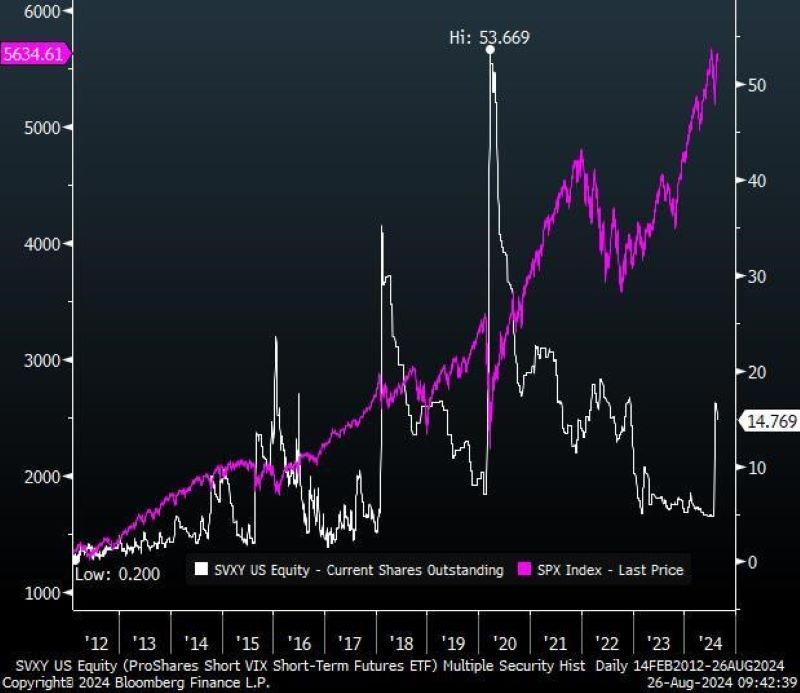Volatility Selling In Times of Market Stress
August 29, 2024

In May, I attended a derivatives conference, when the 10-day realized volatility of the S&P 500 Index was hovering around 6%.1 During the event, participants discussed the growing popularity of volatility-selling exchange-traded funds (ETFs) and funds, noting how these strategies are suppressing market volatility and potentially setting the stage for the next tail risk event.
This prediction seemed to materialize earlier this month. Concerns about a looming recession and an abrupt unwinding of the Yen carry trade pushed the S&P 500 Index into correction territory. The Chicago Board Options Exchange Volatility Index (VIX), a widely used measure of equity volatility, surged from a low of 16 on August 1 to an intraday high of 65 on August 5.2 This sudden spike in volatility appeared to be a golden opportunity for funds that were positioned long on volatility.
However, the market quickly rebounded, even after the VIX experienced one of its sharpest increases on record. Within two weeks, the S&P 500 Index was nearing new highs, and the VIX returned to 16.3
Today’s Chart of the Week illustrates this dynamic. On the day the VIX reached 65, the number of outstanding shares for ProShares Short VIX Short-Term Futures ETF—a popular ETF that shorts volatility—jumped from about 5 million to 14.8 million. This increase in shares indicates a strong demand for volatility selling, leading to the creation of new ETF shares. The capital inflow into this ETF is mechanically converted into short VIX futures positions, which in turn drives down implied market volatility. Similar patterns can be observed across other volatility-selling ETFs.
When we extend the time horizon, this phenomenon becomes even more apparent. Every significant correction in the S&P 500 Index and subsequent spike in volatility is met with a sharp increase in volatility selling.
There’s nothing wrong with selling volatility during a spike, especially if it’s done in moderation. Volatility typically can't remain elevated for long because fear is not a permanent state of mind. However, this behavior tends to depress volatility more quickly than usual after the initial jump.
Key Takeaway
Volatility selling has become increasingly popular, particularly during periods of elevated volatility. This strategy can be highly effective if executed with the right position sizing.
Sources:
1,2,3Bloomberg
This material is for informational use only. The views expressed are those of the author, and do not necessarily reflect the views of Penn Mutual Asset Management. This material is not intended to be relied upon as a forecast, research or investment advice, and it is not a recommendation, offer or solicitation to buy or sell any securities or to adopt any investment strategy.
Opinions and statements of financial market trends that are based on current market conditions constitute judgment of the author and are subject to change without notice. The information and opinions contained in this material are derived from sources deemed to be reliable but should not be assumed to be accurate or complete. Statements that reflect projections or expectations of future financial or economic performance of the markets may be considered forward-looking statements. Actual results may differ significantly. Any forecasts contained in this material are based on various estimates and assumptions, and there can be no assurance that such estimates or assumptions will prove accurate.
Investing involves risk, including possible loss of principal. Past performance is no guarantee of future results. All information referenced in preparation of this material has been obtained from sources believed to be reliable, but accuracy and completeness are not guaranteed. There is no representation or warranty as to the accuracy of the information and Penn Mutual Asset Management shall have no liability for decisions based upon such information.
High-Yield bonds are subject to greater fluctuations in value and risk of loss of income and principal. Investing in higher yielding, lower rated corporate bonds have a greater risk of price fluctuations and loss of principal and income than U.S. Treasury bonds and bills. Government securities offer a higher degree of safety and are guaranteed as to the timely payment of principal and interest if held to maturity.
All trademarks are the property of their respective owners. This material may not be reproduced in whole or in part in any form, or referred to in any other publication, without express written permission.
